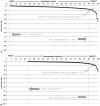The relationships between lost work time and duration of absence spells: proposal for a payroll driven measure of absenteeism
- PMID: 18617841
- PMCID: PMC4495886
- DOI: 10.1097/JOM.0b013e31816b44dd
The relationships between lost work time and duration of absence spells: proposal for a payroll driven measure of absenteeism
Abstract
Objective: To propose a standard measure of absenteeism (the work lost rate [WLR]) be included in future research to facilitate understanding and allow for translation of findings between scientific disciplines.
Methods: Hourly payroll data derived from "punch clock" reports was used to compare various measures of absenteeism used in the literature and the application of the proposed metric (N = 4000 workers).
Results: Unpaid hours and full absent days were highly correlated with the WLR (r = 0.896 to 0.898). The highest percentage of unpaid hours (lost work time) is captured by absence spells of 1 and 2 days duration.
Conclusion: The proposed WLR metric captures: 1) The range and distribution of the individual WLRs, 2) the percentage of subjects with no unpaid hours, and 3) the population WLR and should be included whenever payroll data is used to measure absenteeism.
Conflict of interest statement
Competing Interests: Dr Cullen, Mr. Slade, Ms. Cantley, Ms. Vegso, and Ms. Fiellin provide consultant services to Alcoa Inc, under a research or service agreement With Yale University.
Figures









References
-
- Walsh DC, Conner E, Tracey LV, Goldberg GA, Egdahl RH. Posthospital convalescence and return to work. Health Aff. 1989;8:76–90. - PubMed
-
- Chadwick-Jones J. Social Psychology of Absenteeism. New York: Praeger; 1982.
-
- Goodman RS. Absenteeism. San Francisco: Jossey-Bass Inc; 1984.
-
- Steers RM, Rhodes SR. Major influences on employee attendance: a process model. J Appl Psychol. 1978;63:391–407.
-
- Bureau of Labor Statistics. USDOL. Current Population Survey. Bureau of Labor Statistics; 2007.
Publication types
MeSH terms
Grants and funding
LinkOut - more resources
Full Text Sources

